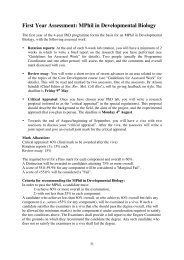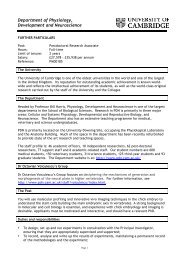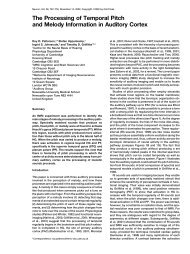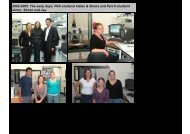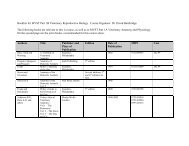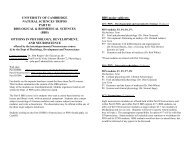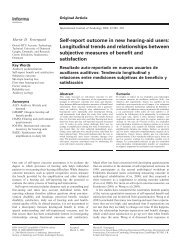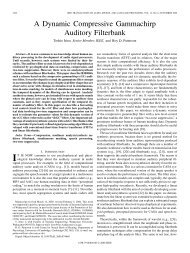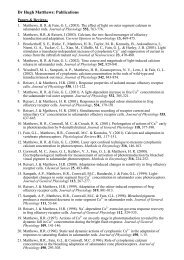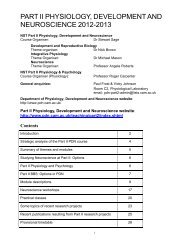FRIDAY MORNING, 20 MAY 2005 REGENCY E, 8:30 A.M. TO 12:00 ...
FRIDAY MORNING, 20 MAY 2005 REGENCY E, 8:30 A.M. TO 12:00 ...
FRIDAY MORNING, 20 MAY 2005 REGENCY E, 8:30 A.M. TO 12:00 ...
Create successful ePaper yourself
Turn your PDF publications into a flip-book with our unique Google optimized e-Paper software.
2:<strong>30</strong><br />
5pBB2. A system to evaluate and compare transducers used for lung sound research. Steve S. Kraman, George R. Wodicka,<br />
Gary A. Pressler, and Hans Pasterkamp Kentucky Clinic J515, Univ. of Kentucky, Lexington, KY 40536 Purdue Univ., West<br />
Lafayette, IN 47907 Purdue Univ., West Lafayette, IN 47907 Univ. of Manitoba, Winnipeg, MB, Canada<br />
Since lung sounds were first recorded and analyzed in the 1960s, a variety of custom made or adapted transducers have been used<br />
for detecting these sounds. There is no standard lung sound transducer nor have those in use been adequately compared. To address<br />
this problem, a test platform was constructed that provides a stable and reproducible sound source coupled to a viscoelastic surface<br />
that is mechanically and acoustically similar to human skin and subcutaneous tissue as judged from comparisons with similar<br />
thicknesses of fresh meat and fat. The device was designed to be equally suitable for air-coupled microphones and for accelerometers.<br />
When driven by a broadband noise source, the acoustic amplitude at the surface of the platform was found to be relatively uniform<br />
from 1<strong>00</strong> to 1<strong>20</strong>0 Hz. The system was used to evaluate a variety of lung sound transducers. They were found to vary significantly in<br />
frequency response with no device appearing to be adequate as an all-purpose lung sound sensor. It is concluded that lung sound<br />
characteristics are likely to be significantly affected by the type of sensor used to acquire the sound. This makes comparisons between<br />
differently equipped laboratories difficult.<br />
2:55<br />
5pBB3. Vascular sounds as an indicator of hemodialysis access patency.<br />
Sandler Rush Medical College, Chicago, IL 60607<br />
Hansen Mansy, Silas Hoxie, Nilesh Patel, and Richard<br />
Background: Vascular access for renal dialysis is a lifeline for about <strong>20</strong>0 <strong>00</strong>0 individuals in North America. Stethoscope auscultation<br />
of vascular sounds has some utility in the assessment of access patency, yet may be highly skill dependent. The objective of this<br />
study is to identify acoustic parameters that are related to changes in vascular access patency. Methods: Fifteen patients participated<br />
in the study. Their vascular sounds were recorded before and after angiography, which was accompanied by angioplasty in most<br />
patients. The sounds were acquired using two electronic stethoscopes and then digitized and analyzed on a personal computer. Results:<br />
Vessel stenosis changes were found to be associated with changes in acoustic amplitude and/or spectral energy distribution. Certain<br />
acoustic parameters correlated well correlation coefficient0.98, p less than 0.<strong>00</strong>01 with the change in the degree of stenosis,<br />
suggesting that stenosis severity may be predictable from these parameters. Parameters also appeared to be sensitive to modest<br />
diameter changes greater than <strong>20</strong>%, (p less than 0.<strong>00</strong>5, Wilcoxon rank sum test. Conclusions: Computerized analysis of vascular<br />
sounds may have utility in vessel patency surveillance. Further testing using longitudinal studies may be warranted. Work supported<br />
by NIH/NIDDK DK 59685.<br />
3:<strong>20</strong>–3:<strong>30</strong> Break<br />
Contributed Papers<br />
3:<strong>30</strong><br />
5pBB4. Computational and experimental models for sound<br />
transmission in the pulmonary system and chest to aid in medical<br />
diagnosis. Serhan Acikgoz, Thomas J. Royston, M. Bulent Ozer Univ.<br />
of Illinois at Chicago, 842 W. Taylor St. MC 251, Chicago, IL 60607,<br />
Hansen A. Mansy, and Richard H. Sandler Rush Univ. Medical Ctr.,<br />
Chicago, IL 606<strong>12</strong><br />
Acoustic wave propagation in the pulmonary system and torso is simulated<br />
by coupling a numerical acoustic boundary element model that predicts<br />
sound propagation throughout the solid tissues with a proven comprehensive<br />
analytical model for sound wave propagation in the airways of<br />
the bronchial tree that is valid up to at least 2 kHz. This approach enables<br />
modeling various pathologies that result in structural changes in the lung<br />
and/or changes in breath sound source and strength. The model may be<br />
also used to predict the resulting acoustic changes measured by acoustic<br />
sensors, e.g., stethoscopes, accelerometers, or other skin-contact sensors.<br />
Experimental studies in a novel lung phantom model are used to partially<br />
validate the computational model. This study focuses on low audible frequencies,<br />
i.e., less than 2 kHz. This range encompasses naturally generated<br />
respiratory sounds that have been shown to have diagnostic value, as well<br />
as externally-introduced vibro-acoustic stimuli used for diagnosis. Work<br />
supported by NIH EB <strong>00</strong>3286-01.<br />
3:45<br />
5pBB5. Recent developments in the characterization of anisotropic,<br />
biological media utilizing magnetic resonance elastography. Anthony<br />
J. Romano, Nicolas P. Valdivia, Philip B. Abraham, Joseph A. Bucaro<br />
Naval Res. Lab., 4555 Overlook Ave, Washington, DC <strong>20</strong>375-53<strong>20</strong>,<br />
romano@pa.nrl.navy.mil, Philip J. Rossman, and Richard L. Ehman<br />
Mayo Clinic and Foundation, Rochester, MN 55905<br />
In this paper, we present recent developments in the characterization of<br />
anisotropic, biological media utilizing displacements measured with dynamic<br />
MRE. In one approach, a waveguide constrained analysis is applied<br />
to physical structures such as muscle, which evaluates the velocities of<br />
wave propagation along arbitrarily oriented fibers or fiber bundles in a<br />
local fashion, utilizing a spectral filter and a sliding window, spatial Fourier<br />
transform. In a second approach, the anisotropic equations of elasticity,<br />
in variational form, are inverted for a determination of the complex<br />
moduli comprising the medium. Issues concerning ill-conditioning, the<br />
effects of boundary conditions, and multiaspect excitation requirements<br />
will be addressed, as well as a discussion concerning the models which are<br />
appropriate for various physical situations. These two complementary<br />
methods of analysis will be demonstrated utilizing both phantom as well<br />
as in vivo dynamic displacement measurements.<br />
2615 J. Acoust. Soc. Am., Vol. 117, No. 4, Pt. 2, April <strong>20</strong>05 149th Meeting: Acoustical Society of America 2615<br />
5p FRI. PM



